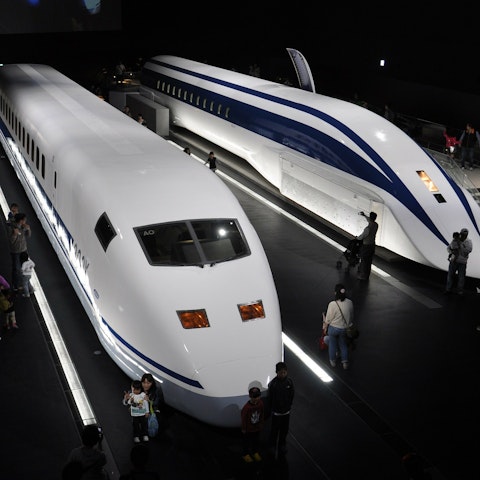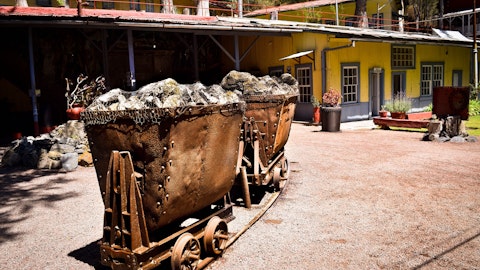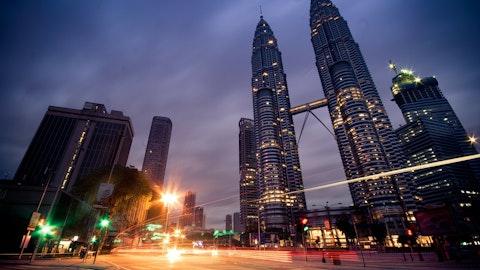In this article, we will be taking a look at 20 countries with the largest high speed rail networks. If you want to skip our detailed analysis of the bullet train / high speed rail market, you can go directly to see 5 Countries With Largest High Speed Rail Network.
High speed rail or bullet trains run faster than traditional rail transport. These trains operate on standard gauge tracks, and can cover huge distances in less cost and less time. With regards to the definition of high speed rail, the International Union of Railways (UIC) considers a commercial speed of 250 km/h to be the principal criterion to define high speed rail.
Rail networks and railroads can connect cities and regions, making it easier for people to travel and collaborate. This helps boost overall economic development while also leading to increased investment, job creation, and innovation. We can expect higher investments in high speed rail in the future as technology continues to improve and the demand for speedy, cost-effective transport goes up.
High Speed Rail Market: Riding the Wave of Growth
Some of the cities around the world with the best public transportation have extensive railway networks. However, previously, the COVID-19 crisis created a hindrance in the overall rail market. Governments around the world imposed lockdowns, restricted traveling, and businesses could only run partially. Low demand and decreasing consumer interest had negatively influenced the market. However, due to the rising demand for faster commute and transportation post-pandemic, the high speed rail market is anticipated to grow in the coming years.
According to a report by Allied Market Research, the global high speed and bullet train market size was valued at $42.5 billion in 2021. The market is expected to grow at a compound annual growth rate of 6.3% during 2022-2031, pushing the market to reach around $77.6 billion by the end of the forecasted period. High speed trains are expected to minimize traffic congestion while also providing comfortable and speedy movement from one place to another. There has been an increase in demand for high speed rail networks as high speed or bullet trains can cover large distances in little time and don’t cost much. The surge in demand for safe, secure, and efficient transport as well as rising use of public transport services is expected to drive the growth of the high speed rail market. Some of the key players in the high speed rail market that are expected to benefit from increased demand include Alstom SA (EPA:ALO), ABB Ltd. (NYSE:ABB), and Siemens AG (ETR:SIE).
The demand for high speed railway to deliver various services such as passenger and freight operation has witnessed significant growth. In recent years, passenger ridership in the railway industry surged as compared to other public transit. The demand for cost effective and efficient rail solutions has also increased because of the reduced commute time and enhanced travel experience, and this trend is expected to continue in the forecast period.
On August 9, Reuters reported that US passenger railroad Amtrak and Texas Central Partners are seeking federal grants for proposed high speed rail service between Dallas and Houston. The proposed project would mean that a trip between the two major US metropolitan areas would take less than 90 minutes. As part of the 2021 massive infrastructure bill, Congress approved $66 billion for rail, with Amtrak receiving $22 billion. The Amtrak Acela, fastest US passenger train, travels up to 240 km/h but the aging infrastructure suppresses that speed along much of the route. The report also mentions that for a $12 billion Las Vegas to Southern California high speed rail project, Brightline West is seeking $3.75 billion in federal funding. The aim is to complete the project before the 2028 Los Angeles Olympics.
Further, improvements in railway infrastructure, particularly in developing countries, and completion as well as revival of high speed rail line projects is expected to create numerous opportunities for market expansion. On July 11, Reuters reported that Malaysia is seeking proposals from private firms to revive a multi-billion dollar project to develop a high-speed railway between its capital Kuala Lumpur and neighbor Singapore. More than 2 years ago, the project was estimated to cost around $17 billion and companies from South Korea, Japan, China, and Europe had expressed an interest in contracts to finance, build, and operate the trains and rail assets.
However, high capital requirement combined with global inflation could hamper the growth of the high speed rail market. On March 9, Reuters reported that after the cost of the HS2 rail project surged yet again, Britain is going to delay building parts of the new high speed railway linking London and northern England. Companies involved in the HS2 rail project, which is billed as one of the largest infrastructure projects in Europe, include Balfour Beatty Plc (LON:BBY), Kier Group Plc (LON:KIE), and Vinci SA (EPA:DG). The project aims to help Britain catch up with other European countries with extensive high speed rail networks. However, because of the significant inflationary pressure and increased project costs, the government said construction of a section in central England would be delayed.
Big Players in the High Speed Rail Market
ABB Ltd. (NYSE:ABB) is a key player in the high speed rail market. The Swedish-Swiss multinational technology group is a premier manufacturer of traction systems and its traction technology is used in high speed trains across the globe. The company has supplied various equipment to power high speed trains including, but not limited to, gas-insulated switchgear technology, static var compensators, and traction transformers.
On July 11, CNBC reported that Alstom SA (EPA:ALO) and Siemens AG (ETR:SIE) are preparing for a passenger rail boom in the US as investment is expected to increase in passenger rolling stock across North America, which includes metro, passenger coaches, light rail, high speed rail, and locomotives. The Infrastructure Investment and Jobs Act (IIJA), which was passed in 2021, provided a significant boost to the rail industry as it designated $66 billion to improve the country’s rail system. President and CEO at Siemens AG (ETR:SIE) Mobility North America, Marc Buncher, said:
“I think passenger rail in the United States has been a little bit slow in years past because of funding.
If you look at the federal funding that other nations get, it’s tremendous. Federal funding is the one piece that we need. And now that we have it, I think you’re going to see a tremendous amount of growth in the industry.”
The report also mentions that Alstom SA (EPA:ALO) at its facility in Hornell, New York, is working on completing an order for Amtrak, the federally owned US passenger train operator, to upgrade its fleet of Acela trains. Scott Sherin, Chief Commercial Officer at Alstom SA US (EPA:ALO), said:
“Today you probably have about a half dozen different rolling stock suppliers in the U.S. that are building trains.
The challenge had always been the fragility of the supply chain behind them. And what we’ve seen with the investment that Amtrak has made in these next-generation high-speed trains is: We’ve brought about a dozen different suppliers from primarily Europe that have set up and done foreign direct investment in the U.S. and have set up factories and … capability.”
On September 6, The Wall Street Journal reported that two European giants, Alstom SA (EPA:ALO) and Siemens AG (ETR:SIE), are waging rival campaigns for a $12 billion high speed train to Las Vegas, as they hope to finally make a big business out of high speed rail in the US. The fierce competition between Alstom SA (EPA:ALO) and Siemens AG (ETR:SIE) reflects the size of the opportunity for the train makers, who are hopeful that the infrastructure law and high speed rail projects will strengthen the promise of true high speed rail investment and services in the US. Alstom SA (EPA:ALO) executives have pressed their case in part on their experience building the replacement for Amtrak’s first-generation Acela, the $2 billion program for the fastest passenger rail fleet in use in America.
On 25 July, Alstom SA (EPA:ALO) announced that over the first quarter of 2023/24, from 1 April to 30 June 2023, EUR 3.9 billion of orders were booked and sales reached EUR 4.2 billion in the quarter, up 4.3% versus last year. The results are in line with the announced growth trajectory. Sales in Rolling Stock in the quarter stood at EUR 2.29 billion, up 5.5% versus the first quarter of 2022/23.
Now that we have discussed some recent developments and trends in the global high speed rail network, let’s take a look at 20 countries with largest high speed rail network.

Pixabay/Public Domain
Methodology
In this article, we have listed 20 countries with largest high speed rail network. To collect data for our list, we consulted a report published by the International Union of Railways (UIC) on global high speed data. We used data obtained for the latest year, which is 2022, in their dataset to rank the 20 countries with largest high speed rail network based on the length of the high speed network in commercial operation in each country. The lengths of the high speed networks in all the countries listed in this article are measured in kilometers (km). The 20 countries with the largest high speed rail networks are listed below in ascending order.
20 Countries With Largest High Speed Rail Network
20. Denmark
Length Of The High Speed Rail Network: 56 Kilometers
First up on our list of 20 countries with largest high speed rail network is Denmark with 56 kilometers of high speed rail network. The Copenhagen–Ringsted Line, which was opened in 2019, was the first high speed railway in Denmark. Moreover, many high speed railway lines are currently under planning in Denmark.
19. The Netherlands
Length Of The High Speed Rail Network: 90 Kilometers
The length of the high speed rail network in commercial operation in the Netherlands reaches 90 kilometers. High speed rail services started in 2009 in the Netherlands with the HSL – Zuid line that connects the Randstad through Brussels to the European high speed rail network.
Some of the key players in the global high speed rail market include Alstom SA (EPA:ALO), ABB Ltd. (NYSE:ABB), and Siemens AG (ETR:SIE).
18. United Kingdom
Length Of The High Speed Rail Network: 113 Kilometers
With 113 kilometers of high speed rail network, the United Kingdom is another European country that made it to our list of countries with largest high speed rail network. The United Kingdom is looking to increase and improve their high speed rail network and since 2019 construction has been ongoing on High Speed 2 (HS2), a major new purpose-built high-speed rail line, which will connect London with major cities in the North and the Midlands while also reducing journey times to Scotland.
17. Switzerland
Length Of The High Speed Rail Network: 176 Kilometers
Switzerland ranks at the number 17 spot in our list of 20 countries with largest high speed rail network. With two new lines and three new base tunnels, the length of the high speed rail network in commercial operation in Switzerland stands at 176 kilometers.
16. Morocco
Length Of The High Speed Rail Network: 186 Kilometers
In Morocco, the first high speed rail line was launched in 2018. The first of its kind on the continent of Africa, it is called Al Boraq in reference to the creature that transported the Islamic prophets. The line is constructed in two sections, and the new route from Tangier to Kenitra has an impressive top speed of 320 kilometers per hour. The length of the high speed rail network in Morocco is 186 kilometers.
15. Belgium
Length Of The High Speed Rail Network: 209 Kilometers
With 209 kilometers of high speed rail network, Belgium ranks at the number 15 spot in our list of 20 countries with largest high speed rail network. While four high speed train services currently operate in the country, Belgium’s rail network provides mostly international connections from Brussels to France, Germany and The Netherlands.
14. Poland
Length Of The High Speed Rail Network: 224 Kilometers
High speed rail service opened in Poland in 2014, with the presentation of twenty non-tilting Pendolino train sets that would operate on four designated lines stemming out from Warsaw. As of 2022, the length of the high speed rail network in commercial operation in Poland is 224 kilometers.
13. Austria
Length Of The High Speed Rail Network: 254 Kilometers
With 254 kilometers of high speed rail network, Austria takes the 13th spot in our list of 20 countries with largest high speed rail network. We may see Austria rank much higher in the future as there are many high speed rail projects under construction in Austria that are expected to be completed within the next 10-15 years. For instance, the Brenner Base Tunnel which is currently under construction will allow speeds of up to 250 km/h.
Some of the prominent players in the global high speed rail market that are expected to benefit from high speed rail expansion around the world include Alstom SA (EPA:ALO), ABB Ltd. (NYSE:ABB), and Siemens AG (ETR:SIE).
12. Saudi Arabia
Length Of The High Speed Rail Network: 449 Kilometers
With 449 kilometers of high speed rail network in commercial use, Saudi Arabia is home to the world’s first desert high speed railway. Haramain Express is also the first double-track electrified high speed railway in Saudi Arabia, and it has brought a new experience of traveling on land in the country. Construction began in 2009, and with Chinese companies involved in the construction of the project, it was finally opened to the public in 2018.
11. USA
Length Of The High Speed Rail Network: 735 Kilometers
Despite being one of the world’s first countries to get high speed trains, USA’s high speed rail network failed to spread. With 735 kilometers of high speed rail network, the USA ranks at the 11th spot in our list of 20 countries with the largest high speed rail network. Amtrak’s Acela trains can reach impressive top speeds of 265 km/h. Other services reaching lower top speeds are prevalent in the US as well.
10. Sweden
Length Of The High Speed Rail Network: 860 Kilometers
Sweden’s public transport system is considered to be one of Europe’s most efficient. As of 2022, Sweden has 860 kilometers of high speed rail network in commercial use. Many trains in Sweden, including the SJ High Speed trains, can run at high speeds and there are hundreds of kilometers of track ready for operation in the country.
9. South Korea
Length Of The High Speed Rail Network: 873 Kilometers
High speed rail service in South Korea for commercial use was first launched in 2004. As of 2022, South Korea has 873 kilometers of high speed rail network and with that it ranks at the number 9 spot in our list of 20 countries with the largest high speed rail network. The country has 2 high speed rail operators, Super Rapid Train and Korea Train eXpress. In South Korea, high speed trains can run at speeds reaching above 300 km/h on the majority of lines.
8. Italy
Length Of The High Speed Rail Network: 921 Kilometers
The first high speed rail service in Italy opened in 1977. Known as the Direttissima, it connected Rome with Florence and the top speed on the line was 250 km/h. Today, high speed rail consists of 2 lines in Italy, and with a top speed of 300 km/h, they link most of the country’s major cities. Italy has a high speed rail network of 921 kilometers.
7. Turkey
Length Of The High Speed Rail Network: 1,052 Kilometers
Turkey’s first high speed train began running in 2009. Since then, Turkey has expanded its high speed rail network and there are 1,052 kilometers of high speed rail network in commercial use in the country as of 2022. Turkey ranks high among the countries with the largest high speed rail network, and with a number of lines under construction and in the planning phase, Turkey is also aiming to grow its high speed rail network further in the future.
6. Finland
Length Of The High Speed Rail Network: 1,120 Kilometers
As of 2022, Finland has 1,120 kilometers of high speed rail network in commercial use. Tilting Alstom Pendolino high speed trains connect the capital city of Finland, Helsinki, with other major cities in the country, while reaching a maximum speed of 250 km/h.
Click to continue reading and see 5 Countries With Largest High Speed Rail Network.
Suggested Articles:
- 30 Countries with Highest Rates of Violent Crime
- Top 20 Fruit Producing Countries In The World
- 15 Countries That Produce the Most E-waste in the World
Disclosure: None. 20 Countries With Largest High Speed Rail Network is published on Insider Monkey.





